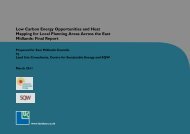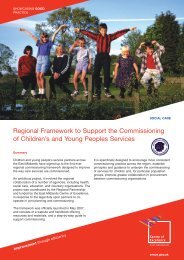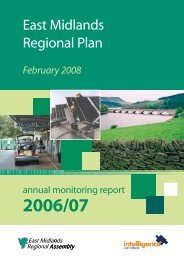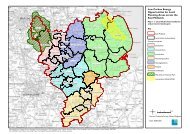East Midlands Regional Spatial Strategy 2005/06
East Midlands Regional Spatial Strategy 2005/06
East Midlands Regional Spatial Strategy 2005/06
You also want an ePaper? Increase the reach of your titles
YUMPU automatically turns print PDFs into web optimized ePapers that Google loves.
Data Analysis<br />
4.46 There continues to be an increase, comparing<br />
2004 and <strong>2005</strong> data, in the amount of floor space<br />
committed to warehousing in the <strong>East</strong> <strong>Midlands</strong>,<br />
particularly in Northamptonshire.There are declines<br />
in floor space committed to retail, offices and<br />
factories although in the case of offices this is a small<br />
decline.The direction of change, with a few<br />
exceptions, is the same across the <strong>East</strong> <strong>Midlands</strong>.<br />
4.47 Table 4.13 indicates that there has also been an<br />
increase in the total of employment land committed<br />
in <strong>2005</strong>/<strong>06</strong> - approximately 3,086 ha., compared to<br />
approximately 2,834 ha. in 2004/05.<br />
4.48 Whilst the number of local authorities able to<br />
supply information on floor space, land losses, retail<br />
commitments and leisure developments showed an<br />
increase on the previous year, this section of the<br />
regional monitoring form was not completed by<br />
many others. The information provided is presented<br />
in the tables above and due to its incompleteness<br />
needs to be viewed with care but it represents some<br />
progress in establishing more detailed monitoring of<br />
land use.The information provided by local<br />
authorities on leisure development, which listed a set<br />
of developments, has not been produced in this<br />
report but is available on the database that supports<br />
the evidence in this report available on<br />
www.emra.gov.uk .<br />
4.49 The rentals paid in all types of non residential<br />
property have increased or in a limited number of<br />
cases remained static. This may in part be due to<br />
inflation but also reflects the continuing demand for<br />
non residential property in the <strong>East</strong> <strong>Midlands</strong>,<br />
reflecting a stable, yet positive, private sector view of<br />
the region.<br />
Policy Commentary<br />
4.50 Ensuring the adequacy of available<br />
employment land supply, including the monitoring<br />
of take-up and the review of land allocations, is<br />
central to the success of the economic policies of the<br />
RSS and a number of studies including the Quality of<br />
Employment Land Supply Study (QUELS) published<br />
in July 2002 has already been undertaken in relation<br />
to this issue. More recently, Roger Tym & Partners<br />
undertook the ‘<strong>East</strong> <strong>Midlands</strong> Land Provision Study’<br />
of employment land provision comparing forecast<br />
future requirements and current supply in order to<br />
propose indicative land requirements to inform the<br />
emerging RSS.Their final report was published in<br />
December 20<strong>06</strong> and highlights the complexities<br />
associated with undertaking such an exercise and<br />
recommends that local employment land reviews<br />
should be undertaken, perhaps by local authorities<br />
working jointly across Housing Market Areas, in order<br />
to develop the overall conclusions of their study.<br />
4.51 The recently completed Strategic Distribution<br />
Study by MDS Modal and Roger Tym & Partners<br />
confirmed the importance of the sector to the<br />
economy of <strong>East</strong> <strong>Midlands</strong>, accounting for an<br />
estimated 9% of both employment and output - a<br />
higher share than in any other region.The study<br />
recommended that a transparent framework is<br />
required to balance market needs against policy<br />
objectives in order to realise the sector’s potential for<br />
the foreseeable future.<br />
4.52 The conclusions reached in the previous AMR in<br />
relation to this policy remain valid. Pressure for the<br />
development of B8 uses, particularly along the M1<br />
corridor, is significant and will continue because the<br />
locational advantages are such that they are<br />
preferred locations for distribution companies.<br />
4.53 In order to meet the <strong>Regional</strong> Economic<br />
<strong>Strategy</strong>’s objectives for economic development it<br />
will be necessary for the regional offer of<br />
employment sites to be improved. A portfolio of<br />
quality sites will be required across the region with<br />
an emphasis on quality sites which will help develop<br />
key sector priorities.<br />
4.54 Northamptonshire is currently in the process of<br />
developing new spatial strategies in line with the<br />
Milton Keynes & South <strong>Midlands</strong> growth agenda and<br />
review of the <strong>Regional</strong> <strong>Spatial</strong> <strong>Strategy</strong>.This requires<br />
the generation of 147,000 new jobs by 2031.To<br />
achieve this various research has been undertaken<br />
such as the Northamptonshire Commercial Property<br />
and Employment Land Assessment, North<br />
Northamptonshire Retail Study and Northampton<br />
Town Centre Study.These will be developed through<br />
emerging core spatial strategies which will in turn<br />
lead to an increase in the growth of retail and<br />
<strong>East</strong> <strong>Midlands</strong> <strong>Regional</strong> <strong>Spatial</strong> <strong>Strategy</strong> Annual Monitoring Report <strong>2005</strong>/<strong>06</strong><br />
57
















